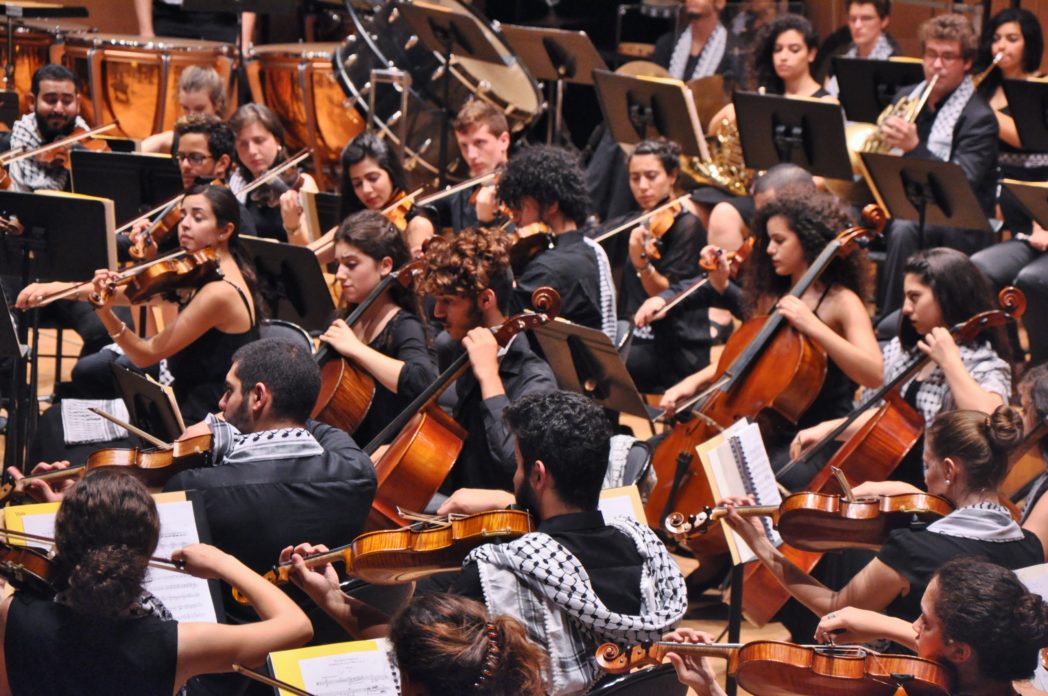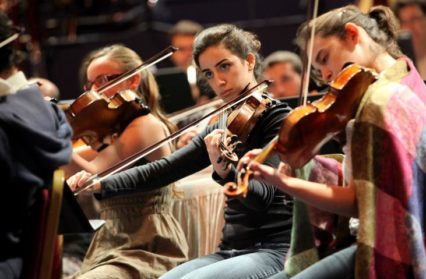St David’s Hall, Cardiff, 30 July 2016 – Palestine Youth Orchestra
Voice: Nai Barghouti
Conductor: Sian Edwards
Beethoven: Overture, Leonore No. 3
Graham Fitkin: Metal
Zakaria Ahmad: Bi Ridhak Ya Khaliqi
Rahbani brothers: Ahtarifu Al Huzna Wal Intithar; Ruddani Ila Biladi
Mussorksky (orch. Ravel): Pictures At An Exhibition
Few music traditions embody the pain and suffering of conflict more than the Middle Eastern. In one sense, therefore, the short tour of Britain by the Palestine Youth Orchestra and its programme of both Western and Eastern music was as much politico-cultural as musical. It was the lot of maestro Carlo Rizzi – enamoured of the gains made by youth music, especially in his adopted Wales – to remind the audience in an introduction that as an example of logistical problems and much else two musicians were unable to obtain visas from Israel to leave Gaza and join the orchestra and its conductor, Sian Edwards, on tour. As it was, the ranks were filled by not only Palestinian residents but also young people of the Palestinian disaspora and some UK youth musicians based at the Royal Conservatoire of Scotland, the Guildhall School of Music and Drama in London and the Royal Welsh College of Music and Drama in Cardiff.

The PYO was created in Ramallah in 2004 by the Edward Said National Conservatory of Music, which now has branches in Bethlehem, Jerusalem, Gaza, and Nablus. Since then it’s enjoyed high-profile activity as ambassadors for Palestine abroad, with appearances in France, Italy, Germany and Greece. Its strings section has performed with Nigel Kennedy at the Proms. These foreign visits are promoted and aided by arts organisations and support groups, in Cardiff with funds raised by the Palestine Solidarity Campaign. The five-venue tour of Britain this year took the orchestra to Perth, Glasgow, Leeds, Birmingham, Cardiff, and – on August 1 – London’s Royal Festival Hall. Sian Edwards first took charge in 2005, and has since conducted it in Palestine, Lebanon, Syria, Jordan, Greece and Italy, as well as here at St David’s Hall.
The keystone of the concert, indeed its lone act of solicitude in a programme albeit pregnant with related metaphor, were three songs in Arabic performed by Nai Barghouti, a specialist in classical Arab singing of the tarab (ecstatic) style made famous by two singers in particular, Oum Kalthoum and Fairuz. ‘Ecstasy’ is an inadequate, shorthand word for a more complex set of musical values, of which the response of the audience is paramount. It’s a style that lends itself to extension (some of Kalthoum’s public performances lasted four hours). Bi Ridhak Ya Khaliqi (With Your Blessing, O My Creator) by Zakaria Ahmad with words by Bairam al-Tunisi, is from a 1944 film with music called Salama, starring Kalthoum as a courtesan who befriends a hermit from Mecca. This was different from Barghouti’s other two items in being accompanied by violin (leader Layth Sidiq), cello (principal Naseem Atrash) and the Arabian lute or oud (first-desk violinist Mostafa Saad).
But the unfurling was similar in being just that, a melismatic vocal line soaked in anguish and threatening to go on forever, just like the suffering with which it is historically associated. The full orchestra accompanied Barghouti in music by the El Rahbani brothers. Ahtarifu Al Huzna Wal Intithar (Grief and waiting are my profession) was written for Fairuz and portrays the reality of the six-day Israeli-Arab war of 1967, when more than 300,000 Palestinians were displaced. Ruddani Ila Biladi (Take Me Back To My Country) is a Rhabani tune that, again, speaks for itself. The orchestral accompaniment to these last two pieces seemed to have its own fissures, being partly modernistic-descriptive but lapsing into a more popular, even banal, idiom, which only served to heighten the vocal part as it continued on its wailing way.
It was perhaps no accident that the concert opened with Beethoven’s ‘Leonore Overture No.3’ from Fidelio, an opera about injustice and tyranny, or that it ended with Ravel’s orchestration of Mussorgsky’s Pictures At An Exhibition and a reminder of the composer’s remarks on the death of the artist Viktor Hartmann, whose work it portrays: ‘Why should a dog, a horse, a rat, live on and creatures like Hartmann must die?’ It’s a paraphrase from King Lear, of course, but in this context shifts to an emotional present. Almost as a relief, and maybe reflecting a state of unpredicated joy, Graham Fitkin’s PYO commission Metal, beginning in the percussion department with the bashing of untuned scaffold tubing and tumbling forth with pitched bells and feverish string playing in particular, was the most convincingly performed of the concert’s Western repertoire. Pride of ownership? Maybe; but every youth orchestra has to be assessed in youth orchestra terms and some of the playing here was blunt-edged and out of true, despite Edwards’s insistence on tempo, especially for Mussorgsky’s perambulations. In the pre-tour circumstances – the sheer getting together of an orchestra where so much is conceived in chaos – any misgivings were short-lived.
Header image : The New Arab



 Enjoyed this article? Support our writers directly by buying them a coffee and clicking this link.
Enjoyed this article? Support our writers directly by buying them a coffee and clicking this link.







